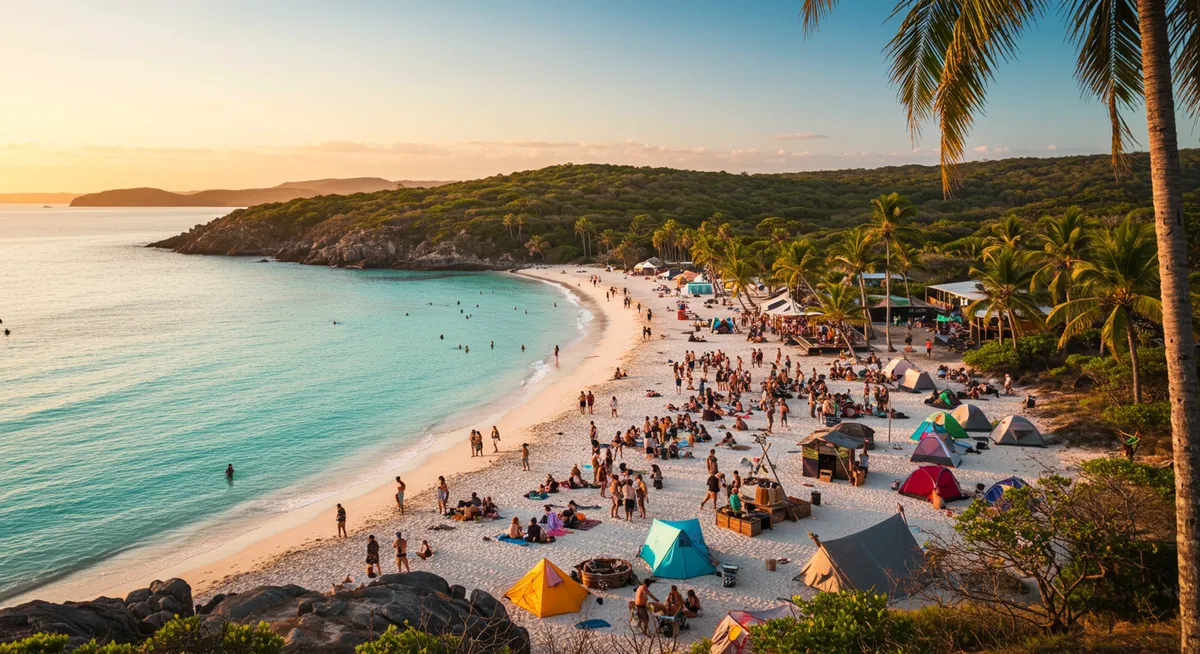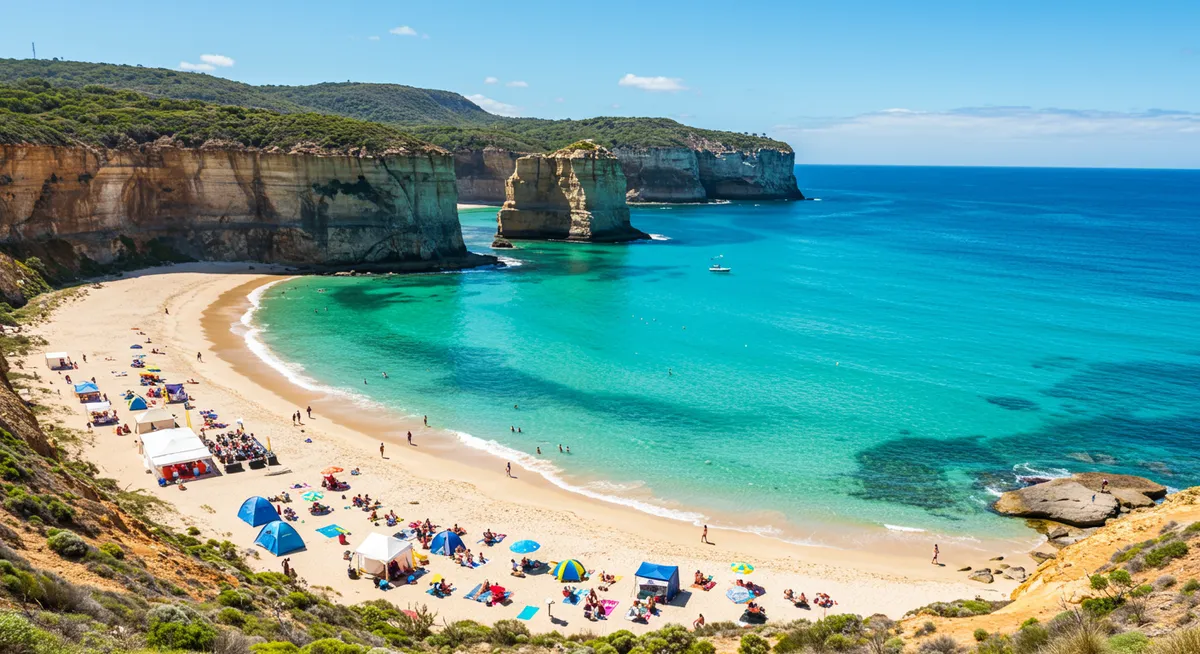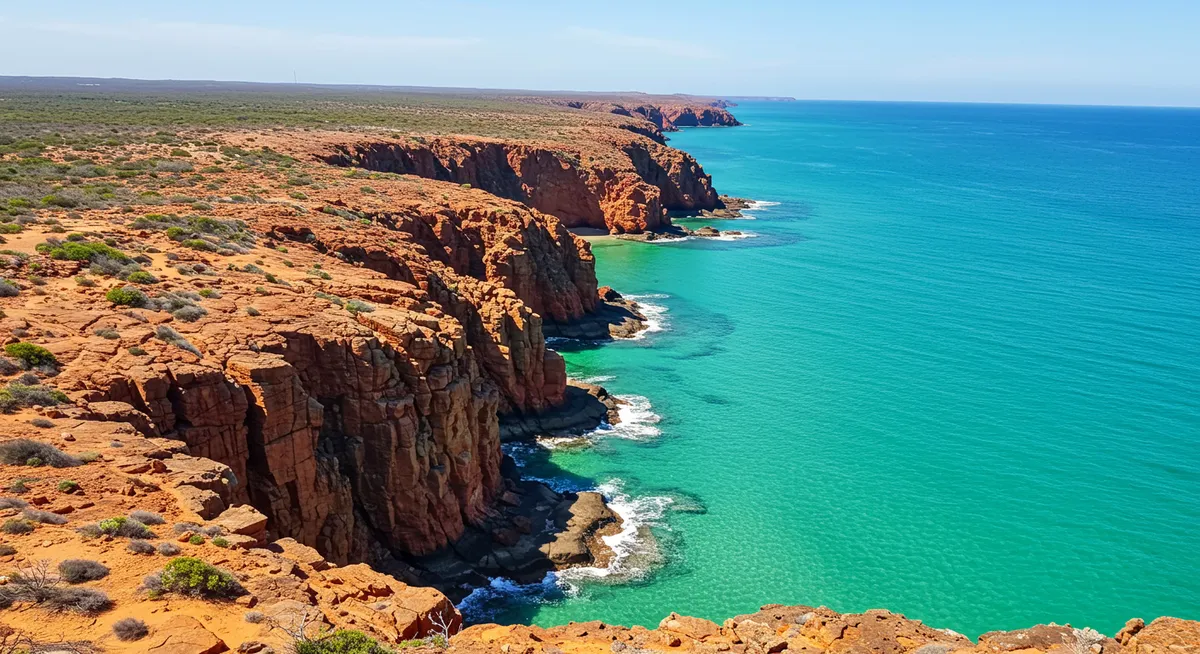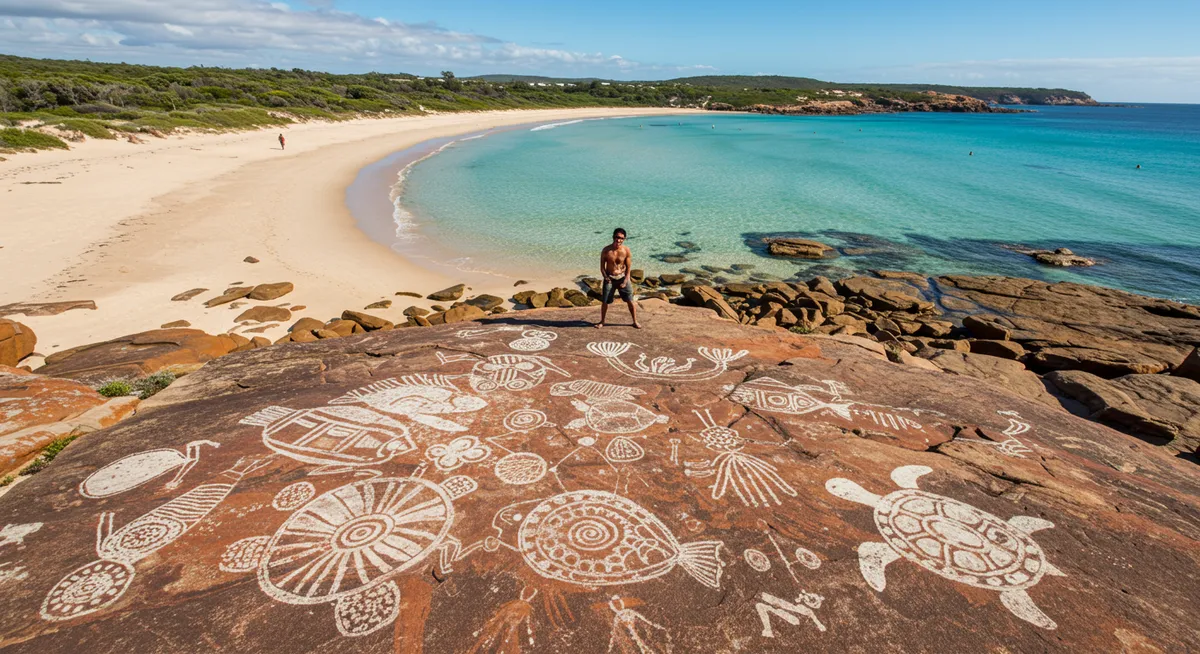Australia's Secret Coastal Treasures

Australia's Secret Coastal Treasures
Australia's 16,000 miles of coastline harbor some of the world's most spectacular beaches. While Bondi, Whitehaven, and Cable Beach draw travelers from across the globe, the vast majority of Australia's shores remain blissfully uncrowded. From the rugged cliffs of Tasmania to the red pindan soil meeting turquoise waters in the Kimberley, Australia's hidden beaches offer extraordinary diversity and natural splendor for those willing to venture beyond the well-traveled paths.

Why Australia's Hidden Beaches Stand Apart
Australia's secret beaches offer distinctive experiences that differentiate them from both international shores and the country's famous beach destinations:
- Pristine Ecosystems: Many remain untouched by development, preserving intact coastal habitats
- Extraordinary Wildlife: From dolphins and migrating whales to kangaroos lounging on the sand
- Geological Wonders: Ancient rock formations, sea caves, and dramatic cliffs frame many hidden shores
- Aboriginal Heritage: Thousands of years of Indigenous connection to coastal lands
- Unrivaled Solitude: Beaches where your footprints might be the only ones in the sand
Western Australia's Remote Treasures
Western Australia's vast, sparsely populated coastline encompasses everything from the temperate southern shores to the tropical north, hiding some of the country's most spectacular beach environments.
Lucky Bay, Cape Le Grand National Park
While not entirely unknown, this beach in Western Australia's southern reaches deserves inclusion for its extraordinary qualities. The sand is so pristine and fine that it squeaks underfoot, and the contrast of the bright turquoise water against the white sand and granite outcrops creates a mesmerizing landscape. The beach's famous kangaroos regularly lounge on the sand, creating a uniquely Australian beach experience.
How to Get There: Drive approximately 45 minutes east of Esperance on sealed roads.
Insider Tip: Visit during Australia's winter or spring (June-November) when temperatures are mild, rainfall is minimal, and the local kangaroos are most active during daylight hours.
Warranambool Beach, Fitzgerald River National Park
Within one of Australia's largest and most floristically diverse national parks, this remote beach combines stunning white sand with the rich colors of the surrounding wilderness. The beach is framed by the distinctive peaks of the Barren Mountains and provides critical habitat for migratory birds and native wildlife.
How to Get There: Four-wheel drive required. Access via Hamersley Drive from either Hopetoun (east) or Bremer Bay (west).
Insider Tip: Visit between September and November when the park's 1,800 native plant species burst into bloom, creating spectacular color against the white sand and blue ocean.
James Price Point, Kimberley
On the remote Kimberley coast north of Broome, this beach showcases the region's signature red pindan cliffs contrasted against bright turquoise waters. The beach stretches for miles with virtually no development and features remarkable dinosaur footprints preserved in the rocks at low tide. The area holds profound cultural significance for the Goolarabooloo people.
How to Get There: Four-wheel drive essential for the unsealed 60km track north of Broome. Check road conditions before departing.
Insider Tip: Time your visit for the lowest spring tides (usually April-October) when dinosaur footprints are most visible along the intertidal zone.

Turquoise Bay, Cape Range National Park
While gaining popularity, this beach in Western Australia's North West Cape still offers remarkable serenity outside peak periods. The beach's name perfectly describes its crystal-clear waters, which lie just meters from Ningaloo Reef—one of the world's most accessible and pristine fringing reefs, offering world-class snorkeling directly from shore.
How to Get There: Approximately 60km from Exmouth via sealed roads through Cape Range National Park.
Insider Tip: Visit outside Australian school holidays and try the "drift snorkel"—starting at the southern end of the bay and letting the current carry you northward over spectacular coral formations.
Northern Territory's Hidden Shores
The Northern Territory's coastline, though less celebrated than other Australian states, harbors remarkable hidden beaches with distinctive tropical characteristics and strong Aboriginal cultural connections.
Cobourg Peninsula Beaches, Garig Gunak Barlu National Park
This remote peninsula in Australia's Top End offers a series of untouched beaches accessible only with special permits. The area features pristine white sand contrasted against red laterite cliffs, with crystal-clear waters teeming with marine life including dugongs and six species of sea turtles. Aboriginal ownership ensures these beaches remain protected from development.
How to Get There: Four-wheel drive essential. Permits required from the Northern Land Council and park authorities. Most visitors arrive via chartered flights to Cobourg or guided tours from Darwin.
Insider Tip: Plan a multi-day visit staying at Cobourg Coastal Camp to explore multiple beaches, including the spectacular Coral Bay with its rainbow-colored coral that washes ashore.
Little Bondi, Murgenella
Despite its name referencing Australia's most famous beach, this Northern Territory hidden gem in Murgenella remains virtually unknown to all but local Aboriginal communities and dedicated fishermen. The beach features palm-fringed golden sand, crystal waters, and exceptional fishing opportunities in the creek systems that enter the ocean nearby.
How to Get There: Four-wheel drive mandatory. Located approximately 350km northeast of Darwin, access requires permits from the Northern Land Council as it crosses Aboriginal land.
Insider Tip: Visit during the dry season (May-September) when road conditions are best and saltwater crocodiles are less active in the beach environment.
Queensland's Secret Paradises
Beyond the Great Barrier Reef's popular tourist spots and the Gold Coast's crowded shores, Queensland hides exceptional beaches that rival their famous counterparts without the crowds.
Butterfly Bay, Hook Island
Hidden in the Whitsunday Islands but far from the busy Whitehaven Beach, this sheltered cove offers pristine coral gardens just meters from shore. Accessible only by boat, the beach features white silica sand and emerald waters framed by tropical forest. The bay's protection from prevailing winds makes it an exceptional snorkeling location year-round.
How to Get There: Charter boat or guided tour from Airlie Beach. No regular ferries service this location.
Insider Tip: Visit during "stinger season" (November-May) when more popular beaches are affected by jellyfish but this protected bay often remains safer due to its orientation and currents.
Orchid Beach, K'gari (Fraser Island)
While K'gari (formerly Fraser Island) draws many visitors, its remote northeastern beach remains largely untraveled. This straight stretch of golden sand extends for miles with nothing but wild dunes, native forests, and the occasional dingo prints interrupting the pristine shoreline. The beach features colored sand cliffs and excellent fishing opportunities.
How to Get There: Four-wheel drive mandatory. Access from the interior tracks of K'gari, crossing to the eastern beach and heading north past Indian Head.
Insider Tip: The beach coincides with the Great Sandy Marine Park, offering exceptional opportunities to spot dolphins, rays, and whales (July-November) just offshore.
Tessellated Pavement Beach, Haggerstone Island
On a remote private island in Far North Queensland, this beach features a remarkable natural phenomenon—a geometric "pavement" of tessellated coral formations exposed at low tide. The small private resort limits visitors to a handful at a time, ensuring this geological wonder and the surrounding white sand beach remain pristine.
How to Get There: Charter flights to nearby Portland Roads, followed by boat transfer arranged by the island owners.
Insider Tip: The beach's best viewing is during spring low tides (usually early morning) when the tessellated coral formations are fully exposed.
New South Wales' Hidden Coastal Gems
Australia's most populous state still harbors remarkable secret beaches, often protected by national parks or challenging access that keeps visitor numbers low.
Maitland Bay, Bouddi National Park
Just 90 minutes north of Sydney but requiring a moderately challenging 20-minute downhill hike, this crescent-shaped beach feels worlds away from the city. The sheltered bay features golden sand, crystal clear water, and exceptional snorkeling around the SS Maitland shipwreck visible at low tide. The surrounding eucalyptus forest creates a distinctively Australian frame for the beach.
How to Get There: Access via the Maitland Bay track from the Information Centre on The Scenic Road, Killcare Heights.
Insider Tip: Visit mid-week during autumn (March-May) when water temperatures remain warm, summer crowds have dispersed, and the challenging return hike up from the beach is more comfortable in cooler weather.
Pebbly Beach, Murramarang National Park
While moderately well-known for its resident kangaroos that frequent the shore, this beach remains uncrowded due to its relative remoteness on the NSW South Coast. The beach features a perfect crescent of golden sand framed by spotted gum forests that grow almost to the water's edge, creating a uniquely Australian coastal landscape.
How to Get There: Unsealed road access from the Princes Highway near Termeil, approximately 3.5 hours from Sydney.
Insider Tip: Visit at dawn when eastern grey kangaroos and wallabies often gather on the beach, creating the iconic Australian experience of native wildlife against a beach backdrop.
Depot Beach, Murramarang National Park
Just north of Batemans Bay but feeling far more remote, this hidden gem features a pristine stretch of sand backed by one of the most significant spotted gum forests in Australia. The beach offers excellent snorkeling around the northern headland rocks and exceptional fishing. Aboriginal middens in the area testify to thousands of years of traditional resource gathering.
How to Get There: Sealed road access via Durras Drive off the Princes Highway.
Insider Tip: The beach's rock platforms at either end offer excellent wildlife viewing, particularly at low tide when the intertidal pools reveal diverse marine ecosystems.
Victoria's Secret Shores
The southernmost mainland state features dramatic coastlines with hidden beaches protected by the challenging Southern Ocean conditions and limited access points.
Johanna Beach, Great Otway National Park
This wild, expansive beach along the Great Ocean Road offers a striking contrast to the region's more famous limestone formations. The powerful Southern Ocean creates dramatic surfing conditions, while the grassy dunes and surrounding farmland create a picturesque setting. Despite its natural beauty, the beach remains uncrowded due to its remote location.
How to Get There: Turn off the Great Ocean Road onto Red Johanna Road, then follow signs to the beach parking area.
Insider Tip: Visit during winter storm season (June-August) to witness the raw power of the Southern Ocean, but stay well back from the water's edge as conditions can be treacherous.
Waterloo Bay, Wilsons Promontory
Hidden within Victoria's most beloved national park, this remote beach requires a challenging 8km hike that keeps visitor numbers minimal. The reward is a perfect crescent of white sand framed by granite headlands and crystal-clear turquoise waters that would look at home in the tropics. The surrounding landscape of granite mountains creates a dramatic backdrop.
How to Get There: Hike required from either Telegraph Saddle car park (via Oberon Bay) or Tidal River (via Oberon Bay track).
Insider Tip: Obtain a permit to camp at the nearby Light Station accommodations to enjoy magical dawn light on the beach before day hikers arrive.
Fairy Cove, Croajingolong National Park
This small, sheltered beach near Mallacoota offers extraordinary seclusion and pristine nature. The beach features fine golden sand framed by smooth granite boulders that extend into the clear waters, creating natural swimming pools. The surrounding national park is a UNESCO Biosphere Reserve with exceptional biodiversity.
How to Get There: A moderately difficult 3km walking track from Shipwreck Creek campground near Mallacoota.
Insider Tip: The beach's orientation makes it one of the east coast's best locations for watching both sunrise over the ocean and sunset behind the forested hills.

Tasmania's Isolated Coastal Treasures
Australia's island state features some of the country's most pristine and dramatic coastal environments, many accessible only by multi-day hikes or boat.
Stephens Beach, Southwest National Park
Located in Tasmania's remote Southwest Wilderness World Heritage Area, this beach offers extraordinary isolation and pristine natural conditions. The broad golden sand beach extends for over 2km, backed by ancient dunes and temperate rainforest. Powerful waves from the Southern Ocean create a dramatic seascape, while the nearby Stephens Bay Needle rock formation adds spectacular visual interest.
How to Get There: Access via the multi-day South Coast Track hike, or by light aircraft to Melaleuca followed by a 10km hike.
Insider Tip: Despite the beach's remote location, the Sand River at the western end provides a protected freshwater swimming location when ocean conditions are too rough.
Crescent Beach, Tasman Peninsula
While the Tasman Peninsula is famous for dramatic features like the Tasman Arch and Blowhole, this hidden beach accessible only by a challenging hike remains virtually unknown. Framed by towering dolerite cliffs that plunge directly into the sea, the small crescent of golden sand offers a secluded haven with exceptional snorkeling in the protected waters.
How to Get There: A challenging 5km return hike from Remarkable Cave car park, involving some rock scrambling and unmarked sections.
Insider Tip: Time your visit for the middle of the day when sunlight penetrates between the towering cliffs to illuminate the beach's golden sand and clear waters.
Bluestone Bay, Freycinet Peninsula
While Wineglass Bay draws crowds to Freycinet National Park, this hidden gem on the peninsula's eastern side offers comparable beauty with fraction of the visitors. The beach features distinctive blue-hued granite boulders contrasted against turquoise waters. The unusual stone formations and sea caves provide exceptional photographic opportunities.
How to Get There: Four-wheel drive track from Cape Tourville Road, followed by a short but steep walking track.
Insider Tip: Visit during the Australian winter (June-August) when the morning light creates a magical blue glow on the distinctive stone formations that give the bay its name.
South Australia's Coastal Secrets
Despite being Australia's driest state, South Australia boasts extraordinary coastal environments where the outback meets the ocean, creating unique beach landscapes.
Ethel Beach, Innes National Park
On the remote southern tip of Yorke Peninsula, this beach combines historic shipwreck remains with pristine nature. The rusted boiler of the SS Ethel remains visible on the beach, creating a striking contrast with the white sand and clear waters. The surrounding limestone cliffs shelter the beach and create dramatic scenery.
How to Get There: Drive through Innes National Park to the designated car park, followed by a short walk down wooden stairs to the beach.
Insider Tip: Visit during winter months (June-August) when southern right whales can often be spotted just offshore during their annual migration.
Almonta Beach, Coffin Bay National Park
On Eyre Peninsula's wild western coast, this remote beach offers extraordinary solitude and pristine conditions. The beach features blindingly white sand contrasted against turquoise waters, with ancient limestone cliffs and native vegetation creating a distinctly Australian backdrop. The waters host diverse marine life, including dolphins and sea lions.
How to Get There: Four-wheel drive required for the sandy tracks through Coffin Bay National Park.
Insider Tip: Low tide reveals extensive rock platforms at the beach's southern end, creating natural infinity pools with stunning ocean views.
Talia Beach, Eyre Peninsula
This remote beach showcases the dramatic meeting of Australia's red outback landscape with the turquoise Southern Ocean. The beach features a series of remarkable granite formations including "The Woolshed," a large sea cave carved by wave action. The contrast of colors—red soil, white sand, blue ocean—creates a distinctly Australian palette.
How to Get There: Drive via Flinders Highway to the signposted turnoff near Sheringa.
Insider Tip: The beach's western orientation makes it one of Australia's best sunset locations, where the setting sun illuminates the red granite formations with golden light.
Essential Tips for Exploring Australia's Secret Beaches
Safety Considerations
Australia's remote beaches require serious preparation and safety awareness:
- Isolation: Many beaches have no mobile coverage and are far from emergency services
- Ocean Conditions: Powerful rips and currents affect many beaches—swim only in designated safe areas
- Wildlife Awareness: From saltwater crocodiles in the north to dangerous jellyfish and sharks
- Sun Protection: Australia has the world's highest skin cancer rates—comprehensive sun protection is essential
- Tide Awareness: Some beaches disappear completely at high tide or have access cut off by rising waters
Seasonal Considerations
Australia's vast geography creates diverse optimal visiting times:
- Northern Australia (NT, FNQ): Dry season (May-October) offers comfortable temperatures and minimal rainfall
- Southern Australia (TAS, VIC, SA): Summer and shoulder seasons (November-April) provide milder conditions
- Western Australia: Spring (September-November) offers wild flowers and comfortable temperatures
- East Coast: Autumn (March-May) provides warm ocean temperatures with fewer crowds
Access and Transportation
Reaching Australia's hidden beaches often requires specialized preparation:
- Four-Wheel Drive: Essential for many beach destinations, particularly in Northern Australia and Tasmania
- Hiking Preparation: Many beaches require walks ranging from 30 minutes to multi-day treks
- Boat Access: Consider charter boats or sea kayaks to reach the most isolated coastal areas
- Permits: Aboriginal land, national parks, and some conservation areas require advance permits
Environmental and Cultural Responsibility
Australia's pristine beaches remain so because of careful management and visitor responsibility:
Environmental Protection
- Leave No Trace: Pack out all trash and leave beaches as you found them
- Wildlife Distance: Maintain appropriate distance from marine and terrestrial wildlife
- Reef Protection: Use reef-safe sunscreen and avoid touching or standing on coral
- Dune Conservation: Stay on marked paths to prevent fragile dune erosion
Aboriginal Cultural Respect
- Sacred Sites: Many coastal areas have deep significance to Traditional Owners
- Permission: Obtain necessary permits before visiting Aboriginal lands
- Cultural Awareness: Learn about the traditional significance of areas you visit
- Indigenous Tourism: Support Aboriginal-owned tourism operations where available

Beyond the Beach: Australia's Coastal Wilderness
The areas surrounding Australia's hidden beaches often offer remarkable natural experiences that enhance a beach visit:
Unique Wildlife Encounters
Australia's isolated evolution has created exceptional coastal wildlife:
- Kangaroos and wallabies that frequent beach areas, especially at dawn and dusk
- Nesting sea turtles on northern beaches (November-February)
- Endemic shorebirds found nowhere else on Earth
- Marine mammals including dugongs, dolphins, and seasonal whales
Ancient Landscapes
Australia's coastline showcases geological wonders:
- Some of Earth's oldest exposed rock formations
- Living fossils in stromatolite formations
- Dramatic volcanic features where recent geological activity meets the ocean
- Limestone caves and blowholes created by millennia of wave action
The Value of Seeking Australia's Hidden Shores
In a world of geo-tagged Instagram spots and crowded tourist beaches, Australia's secret coastal treasures offer increasingly rare opportunities for genuine discovery and connection with nature. The extra effort required to reach these hidden gems—whether a challenging four-wheel drive journey across the Kimberley, a multi-day hike in Tasmania, or simply taking the less-traveled path—inevitably enhances the experience and ensures these special places remain pristine.
For travelers willing to venture beyond the famous shores of Bondi or Whitehaven, Australia's hidden beaches offer extraordinary rewards: wildlife encounters unmarred by crowds, pristine ecosystems functioning as they have for millennia, night skies brilliant with stars undiminished by light pollution, and the profound sense of connection that comes from experiencing landscapes where nature still holds primacy. These secret coastal treasures represent Australia at its most authentic—wild, ancient, and breathtakingly beautiful.
Planning your Australian coastal adventure?
Discover more secret beaches and travel inspiration in our comprehensive guides: